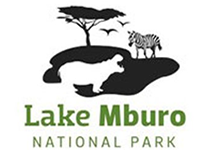Large Grazers and Antelope Species
Lake Mburo National Park is home to the only protected population of impala (Aepyceros melampus) in Uganda.
Estimated densities average 22 individuals per square kilometre in the park’s core woodland sector. They dominate the lightly wooded grassland between Rwonyo and the eastern boundary.
The park also shelters Burchell’s zebra (Equus quagga burchellii), waterbuck (Kobus ellipsiprymnus), bushbuck (Tragelaphus scriptus), and common eland (Taurotragus oryx).
Field observations by Uganda Wildlife Authority in 2023 indicated a stable eland population of approximately 800 individuals distributed across Kazuma and Kigambira sectors.
These grazing species sustain ecological balance by controlling undergrowth, thus maintaining visibility for both research and tourism activities.
Buffalo, Hippos, and Semi-Aquatic Mammals
Buffalo herds occupy the wet grassland fringes and are frequently recorded near the lake margins during the dry season.
The park’s lakes and swamps host an estimated 300 hippos (Hippopotamus amphibius), most visible along the Kigambira channel and Kazuma shore.
Nile crocodiles (Crocodylus niloticus) occur in moderate numbers within Lake Mburo’s deeper zones.
Their presence underscores the park’s efficiency in the aquatic food chain.
Regular monitoring has documented cohabitation patterns between hippos and waterbirds, offering excellent opportunities for ecological photography and avian‑- mammal interaction studies.
Predators and Carnivores
Leopard (Panthera pardus) populations have gradually recovered since 2018, following the reinforcement of conservation patrols.
Although elusive, sightings are common during nocturnal drives. Spotted hyena (Crocuta crocuta) densities are moderate, typically confined to the western thickets near the Rubanga sector.
Serval cats (Leptailurus serval) and side-striped jackals (Canis adustus) complete the carnivore guild. The absence of lions has stabilised prey distribution, resulting in evenly dispersed herds rather than concentrated clusters.
For ecologists, this creates a controlled setting to study herbivore behaviour in predator-limited environments (a detail often overlooked by casual observers).
Primates and Arboreal Mammals
Although the park is predominantly savannah, its riparian forests along the lake inlets sustain populations of vervet monkeys (Chlorocebus pygerythrus), olive baboons (Papio anubis), and bush babies (Galago senegalensis).
The Rubanga Forest fragment remains the leading site for primate research within the park. Its dense canopy structure supports diurnal activity peaks between 0700 and 1000 hours, aligning with visitor bird‑watching schedules.
Nocturnal and Rare Species
Lake Mburo provides one of Uganda’s most reliable settings for viewing nocturnal fauna under guided supervision.
Night drives reveal genets, porcupines, white-tailed mongooses, and occasionally aardvarks (Orycteropus afer).
The introduction of thermal-assisted night observation in 2022 has enhanced the accuracy of nocturnal species monitoring.
Rare records include oribi (Ourebia ourebi) in open grassland zones and the sitatunga (Tragelaphus spekii) within marsh edges, both contributing to the park’s niche value.
